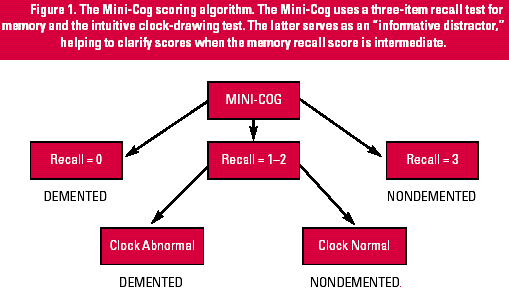
The Mini-Cog is a very simple and quick test carried out by a doctor or clinician. It takes about 3 minutes to administer and is often used in emergency departments to identify people who require further investigation into their clinical presentation.
The test consists of a three item recall and a clock drawing test.
(1)First the ‘patient’ is asked to repeat three unrelated words. This is the same as in the Mini Mental State Examination (MMSE).
(2)The ‘patient’ is then asked to draw a clock. This is the same as the Clock Drawing Test (CDT).
(3)The ‘patient’ is then asked to recall the three words.

Results of the Mini-Cog
If the ‘patient’ is unable to recall any of the three words then they are categorized as ‘probably demented.
If they can recall all three words then they are categorized as ‘probably not demented’. People who can recall one or two words are categorized based on their clock drawing test.
Results of The Clock Drawing Test
If the ‘patient draws a clock that is in any way abnormal they are considered as ‘probably demented’. If the clock is normally constructed then they are considered ‘probably not demented’.
The mini-Cog test results only contribute to a diagnosis of dementia. The test cannot be used in isolation in diagnostic tests for Alzheimer’s disease.
The Mini-Cog is a 3 minute instrument used to screen for cognitive impairment (most often dementia) in older adults. In several different studies, the Mini-Cog was as effective or more effective than the MMSE and other established screening tests. The Mini-Cog is able to screen for both memory and executive function.
In the Mini-Cog, the patient is told three items (such as apple, table, and penny) and is requested to repeat back and remember those three items. The patient is then asked to draw a clock face with all of the numbers, and then draw in the hands of the clock to indicate a certain time, such as 10:50. After the patient has drawn the clock face, he or she is asked to repeat back the three items that were previously stated.
That’s it! The beauty of this test is its simplicity and quickness.
Recall of 0 items indicates dementia.
Recall of 1-2 items with an abnormal clock face indicates dementia.
Recall of 1-2 items with a normal clock face indicates no dementia.
Recall of all 3 items indicates no dementia.
Essentially, the clock face only comes into play when only 1 or 2 items are recalled. If zero items or 3 items are recalled, the diagnosis is clear-cut.